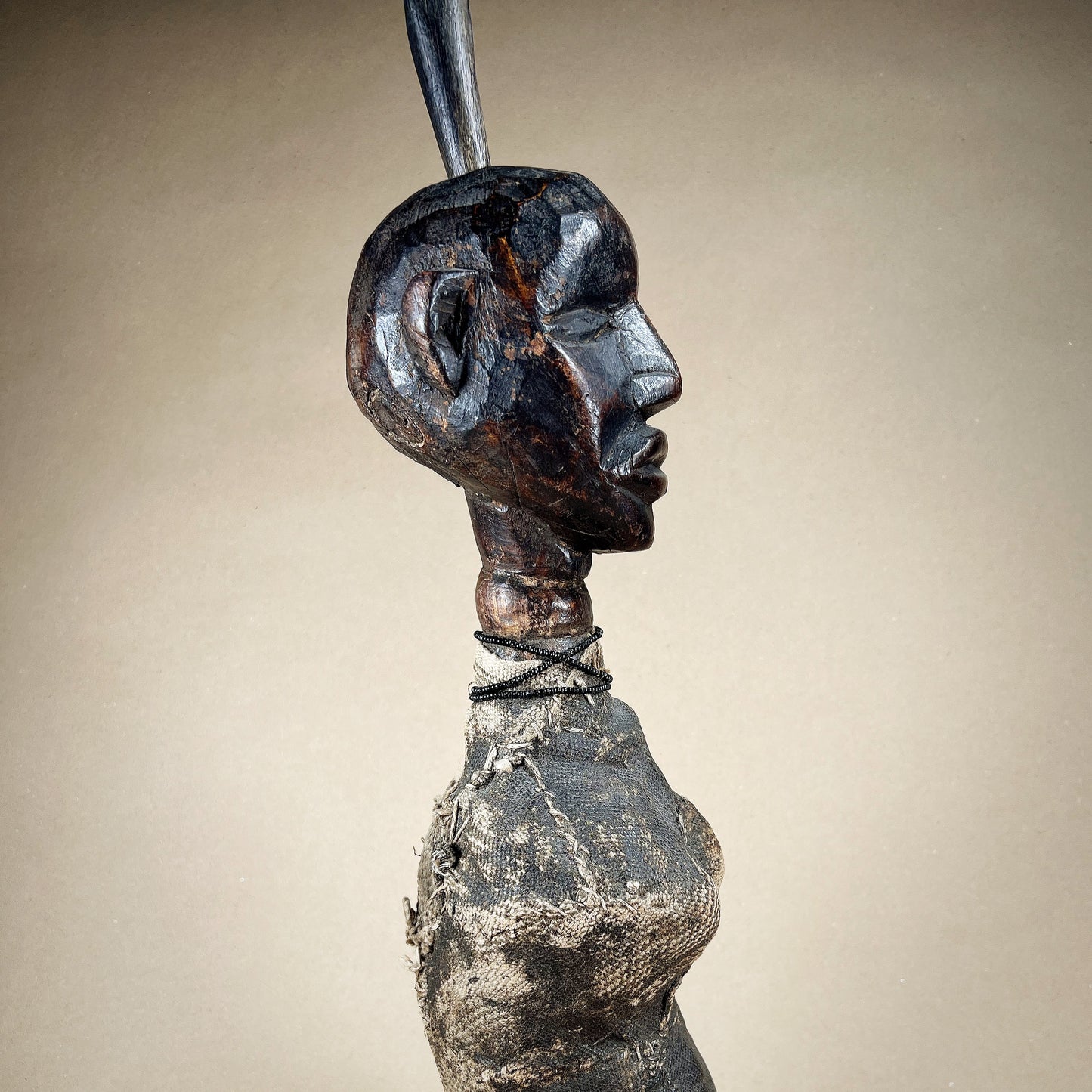Songye Power Figure (Nkisi)
Songye Power Figure (Nkisi)
Couldn't load pickup availability
Songye people, early to mid-20th century, Democratic Republic of the Congo, Central Africa
Absolutely gorgeous and highly unusual Songye power figure, nkisi, carved from a single piece of wood and likely representing a female form. The entire body—lacking visible feet—is enveloped in layers of raffia cloth (mpeko) and packed with sacred empowering substances (bishimba). Beneath the dense wrappings, the hands are probably bent and held against the abdomen or chest, their form now hidden under ritual materials.
A crudely sculpted ovoid head emerges strikingly from the clothed body, coated in dark pigment. From the crown, an impressive bushbuck (ngulungu) horn rises upward, symbolizing the wisdom and authority of the elders. The elongated cylindrical neck is adorned with a necklace of tiny glass trade beads (bipo). The figure’s pronounced, rounded abdomen suggests fertility, vitality, and well-being.
The facial features—almond-shaped slit eyes, large ears, and a delicately formed open mouth—are carved in an unusually expressive and unorthodox manner, giving the piece exceptional character and individuality.
The Songye inhabit a vast region between the Sankuru, Lulua, and Lualaba rivers, encompassing Kasaï-Oriental, Katanga, and parts of the Kivu provinces. Organized into thirty-five subgroups, their political and spiritual structure is led by a paramount chief (Yakitenge) and an intricate hierarchy of elders, nobles, and powerful secret societies. Their origins and early history are closely linked to the neighboring Luba, with whom they share ancestral descent from the mythical figure Kongolo.
Songye religious thought centers on Efile Mukulu, the supreme creator, who brought forth cosmic elements—sun, moon, stars, wind, fire, water, rainbow, and earth. Yet in daily life, ancestral spirits receive the greatest attention. Offerings and sacrifices sustain the well-being of families and communities.
Among the most visible Songye institutions is the Bwadi bwa Kifwebe, the society of masked men whose knowledge of witchcraft (buki/buci) and sorcery (masende) allows them to restore or maintain social balance through ritual dances, initiations, circumcisions, and funerary rites.
Traditional Songye sculpture centers on nkisi (plural minkisi or mankishi), spirit figures through which the ancestors continue to influence the living world. Every community—and many individuals—maintain their own nkisi. A communal nkisi is kept in its dedicated hut (shibo ya bwanga) and consulted for serious concerns such as crop failure, epidemic illness, accusations of sorcery, or territorial conflict. Each figure is overseen by a special guardian (nkunja/kunca), who communicates with the spirit through dreams and states of possession.
The power of an nkisi resides not in the wooden shell but in its bishimba, the sacred charge composed by a spiritual healer (nganga). These materials—often hidden in the belly, around the waist, or sealed within the horn atop the head—include potent substances such as: hawk feathers, lion claws, scales of venomous snakes, umbilical cords of twins, fragments of lightning-struck trees, soil from the footprint of an elephant, and even powerful human materials associated with specific conditions or destinies.
Magnificently wrapped, horned, and densely empowered, this rare nkisi is an exceptional embodiment of Songye ritual artistry, spiritual force, and protective authority.
Excellent condition. Age-related heavy wear and clear evidence of prolonged ceremonial use. Beautifully polished patina with traces of libations and sacrificial offerings. Size approx. 65,5cm x 13,8cm x 14,8cm.
Provenance: Finnish private collection
References and further reading:
Reviewing Power, Process, and Statement: The Case of Songye Figures, Dunja Hersak, African Arts, Vol.43, No.2, pp.38-51, Published UCLA, Summer 2010.
On the Consept of Prototype in Songye Masquerades, Dunja Hersak, African Arts, Vol.45, No.2, pp.12-23, Published UCLA, Summer 2012.
Community Poer Figure: Male (Nkisi), Yaëlle Biro, The Metropolitan Museum of Art, 2018.
Songye, Art & Life in Africa, University of Iowa Stanley Museum of Art.







-
Shipping
The shipment will be prepared in the course of 3-5 days and dispatched via Posti Group Oyj or purchased item(s) can be picked up from our shop during the store's opening hours (Tarkk’ampujankatu 4, 00140, Helsinki, Finland). Within the Finland, all items are shipped via Posti Group Oyj unless otherwise requested. We pack the items carefully and mainly in recycled materials because we want to save nature. You will receive the tracking number for your items by e-mail.
-
Returns
Returns and exchange will be accepted within fourteen days (14) of receipt at the purchaser’s cost to include freight and packaging. Items must be returned in the same condition as when they were shipped, and will not be accepted if damaged or altered in any way. Please inform us via email (info@gotanmaailma.fi) or by calling +358408408352 before sending. We do not accept returns more than 14 days after delivery.







